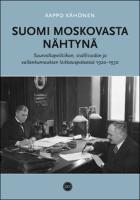Suomi Moskovasta nähtynä
Suurvaltapolitiikan, sisällissodan ja vallankumouksen leikkauspisteessä 1920–1930
| dc.contributor.author | Kähönen, Aappo | |
| dc.date.accessioned | 2021-10-13T13:54:18Z | |
| dc.date.available | 2021-10-13T13:54:18Z | |
| dc.date.issued | 2021 | |
| dc.identifier | ONIX_20211013_9789518584066_50 | |
| dc.identifier | OCN: 1288652815 | |
| dc.identifier.issn | 0073-2559 | |
| dc.identifier.uri | https://library.oapen.org/handle/20.500.12657/50999 | |
| dc.language | Finnish | |
| dc.relation.ispartofseries | Historiallisia Tutkimuksia | |
| dc.subject.classification | thema EDItEUR::N History and Archaeology::NH History::NHB General and world history | en_US |
| dc.subject.classification | thema EDItEUR::J Society and Social Sciences::JP Politics and government::JPA Political science and theory | en_US |
| dc.subject.classification | thema EDItEUR::J Society and Social Sciences::JH Sociology and anthropology::JHB Sociology | en_US |
| dc.subject.other | civil war | |
| dc.subject.other | revolution | |
| dc.subject.other | foreign policy | |
| dc.subject.other | rimstates | |
| dc.subject.other | Soviet Union | |
| dc.subject.other | Finland | |
| dc.title | Suomi Moskovasta nähtynä | |
| dc.title.alternative | Suurvaltapolitiikan, sisällissodan ja vallankumouksen leikkauspisteessä 1920–1930 | |
| dc.type | book | |
| oapen.abstract.otherlanguage | The focus of this research is on Finland’s role in Soviet Union’s calculation of its foreign policy between 1920 and 1930. This was the first decade of both Finnish independence and of Soviet power in Russia. This book answers questions about the objectives of Soviet foreign policy in Finland, on the contacts used by the Soviet legation to obtain information, and on how well the Soviets understood Finland’s objectives. People interested in Finland and in Russian perspectives with regards to foreign policy and neighbouring countries will find much new in this book because it relies on formerly unpublished Russian archival material to form the basis for charting Soviet objectives in Finland. The book shows that the Soviets primarily observed Finland in a larger regional context along with other states on its borders in the Baltic Sea region. The global objectives of the revolution and the Soviet Union, but also the domestic political situation in both countries, are reflected on this framework. The period was characterized by forced collectivization in the Soviet Union and, in Finland, by the rise of the right-wing Lapua Movement that emerged at the onset of the Great Depression, laying the foundations for the most severe crisis in the relations during 1929–1930 when the issues surrounding these events destabilized simultaneously the society and political decision-making in both countries. | |
| oapen.identifier.doi | 10.21435/ht.285 | |
| oapen.relation.isPublishedBy | 51db0f72-616d-4d86-b847-ade19380e08f | |
| oapen.relation.isbn | 9789518584066 | |
| oapen.relation.isbn | 9789518584059 | |
| oapen.relation.isbn | 9789518584042 | |
| oapen.imprint | Finnish Literature Society | |
| oapen.series.number | 4 | |
| oapen.pages | 306 | |
| oapen.place.publication | Helsinki |

